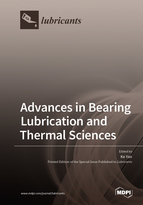Advances in Bearing Lubrication and Thermal Sciences
A special issue of Lubricants (ISSN 2075-4442).
Deadline for manuscript submissions: closed (30 May 2022) | Viewed by 41233
Special Issue Editor
Interests: intelligent detection; software development; CFD simulation
Special Issues, Collections and Topics in MDPI journals
Special Issue Information
Dear Colleagues,
Bearings are currently the most widely used mechanical components. In the process of high-speed and heavy load operation, friction and heat generation between rolling elements, cages and rings increase. At this time, lubrication technology is becoming the key to reducing bearing friction and wear, strengthening bearing heat dissipation, and extending bearing life.
In the last century, important research on various aspects of bearing thermal analysis and corresponding lubrication technology has been extensive. However, as bearing speeds continue to increase, complex operation conditions pose more challenges to bearing thermal analysis. At the same time, the continuous cross-fusion of materials, sensors, big data, and emerging technologies has enabled the continuous expansion of bearing lubrication technology.
The current Special Issue is aimed at the latest developments concerning bearing thermal mechanisms and lubrication technology and the effect of bearing working parameters upon their lubrication performance and thermal behavior.
Prof. Dr. Ke Yan
Guest Editor
Manuscript Submission Information
Manuscripts should be submitted online at www.mdpi.com by registering and logging in to this website. Once you are registered, click here to go to the submission form. Manuscripts can be submitted until the deadline. All submissions that pass pre-check are peer-reviewed. Accepted papers will be published continuously in the journal (as soon as accepted) and will be listed together on the special issue website. Research articles, review articles as well as short communications are invited. For planned papers, a title and short abstract (about 100 words) can be sent to the Editorial Office for announcement on this website.
Submitted manuscripts should not have been published previously, nor be under consideration for publication elsewhere (except conference proceedings papers). All manuscripts are thoroughly refereed through a single-blind peer-review process. A guide for authors and other relevant information for submission of manuscripts is available on the Instructions for Authors page. Lubricants is an international peer-reviewed open access monthly journal published by MDPI.
Please visit the Instructions for Authors page before submitting a manuscript. The Article Processing Charge (APC) for publication in this open access journal is 2600 CHF (Swiss Francs). Submitted papers should be well formatted and use good English. Authors may use MDPI's English editing service prior to publication or during author revisions.
Keywords
- bearing lubrication
- bearing thermal analysis
- dynamic modelling
- temperature monitoring
- lubricants flow simulation
Related Special Issue
- Advances in Bearing Lubrication and Thermodynamics 2023 in Lubricants (15 articles)






